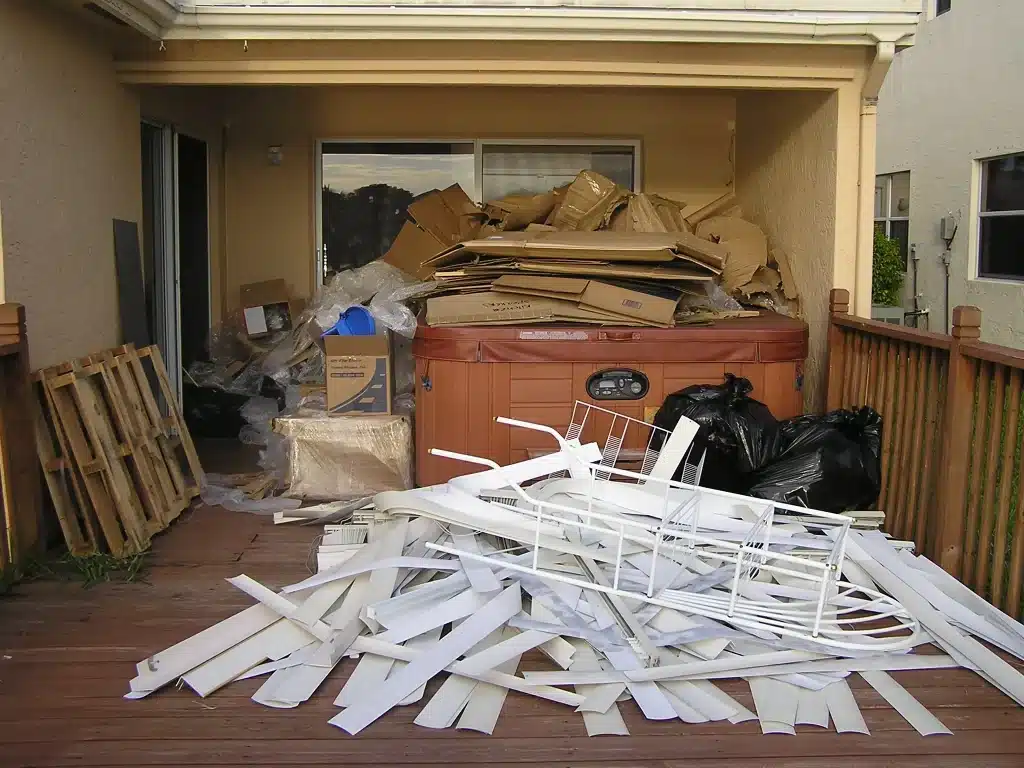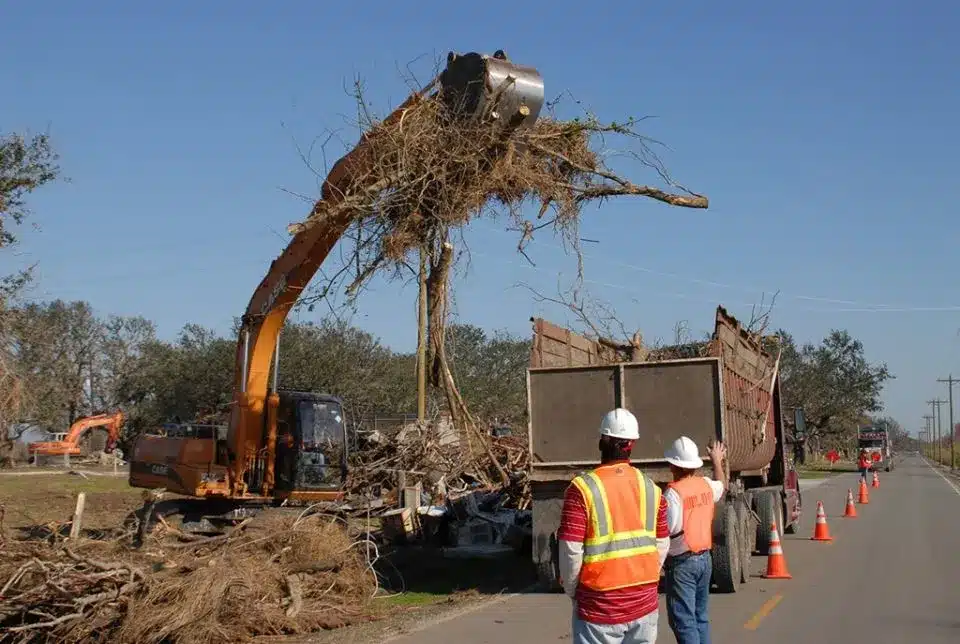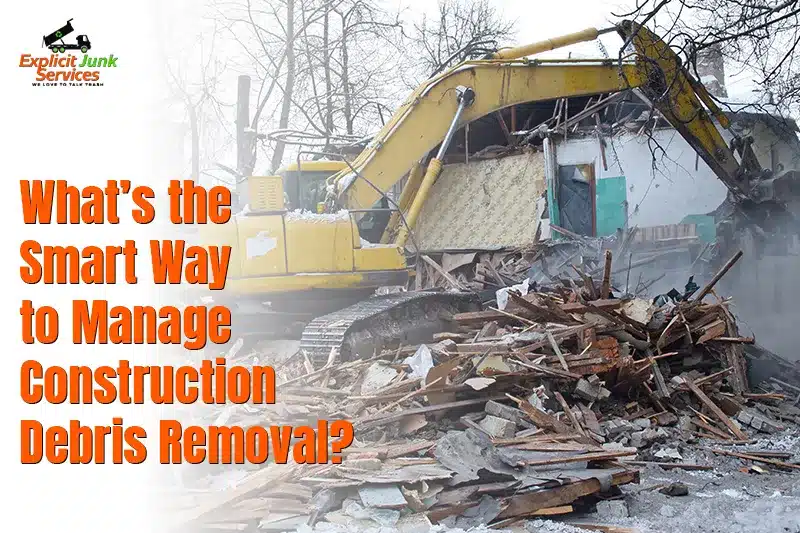Construction cleanup plays a key role in every project and keeps work flowing right. It keeps the site safe and smooth for work. Clean spaces prevent clutter that slows teams and causes mistakes. Safety depends on keeping paths open and removing all hazards fast. Proper cleanup builds trust between workers and project managers.
Every job site has different waste, like wood, drywall, and concrete. Metal pieces, dust, and sharp scraps gather quickly after each task. Without control, they block progress and create risks. A strong plan for construction cleanup helps keep the workflow smooth and steady. Each area stays ready for the next stage of work. Safe debris handling goes beyond simple cleanup and needs care. It involves sorting and moving materials with care.
Workers must wear gear, use the right tools, and follow clear steps. Proper control of waste keeps accidents low and saves time and cost. It also shows respect for safety rules and worker health. By managing waste well, teams avoid costly delays and reduce clutter around machines.
It supports a safer and cleaner site for all staff. From heavy debris to small dust piles, every bit counts toward smooth progress. In this guide, you will find practical ways to manage proper construction clean-up with simple tips. It includes safe debris handling, recycling ideas, and efficient cleanup steps that fit every project size.
Why Proper Debris Management Matters
Job Site Hazards: Nails, Broken Glass, Heavy Materials
Construction waste often hides dangers that risk worker safety. Nails, glass, and heavy debris can cause injuries quickly. Safe cleanup helps prevent falls and cuts. Each site needs strong rules for waste to keep everyone safe and aware.
Workflow Delays Due to Unmanaged Debris
Uncontrolled debris piles up and blocks key work paths. Machines slow down, and teams lose time clearing waste. Proper debris management removes barriers and keeps the schedule on track. Clean job sites boost focus and speed in every step of work.
Compliance with Regulations
Rules for handling building materials disposal exist to protect people and the planet. Sites must sort, store, and move debris the right way. Fines and project delays come from poor control. Following regional laws builds trust and make sure for safety and standards.
Environmental Impact and Landfill Reduction
When waste piles reach landfills, nature pays the price. Sorting and recycling is the process of reducing trash and pollution. Concrete, wood, and metal can all serve new uses. Each load reused cuts landfill growth and helps future construction projects stay eco-friendly.
Organizing Building Materials Disposal
Strong planning ensures building materials disposal stays clean and quick. Workers can separate trash by type and move it safely. Early sorting keeps the work site smooth and prevents confusion. Proper debris management also lowers cost, saves energy, and supports cleaner builds.
Each site that controls its construction waste well gains more than clean ground. It gains safer workflows, lower risks, and a better reputation. Smart cleanup keeps every project moving strong and steady while protecting workers and the world.
Top Tips for Efficient Construction Cleanup
Work Smart: Pack, Transport, and Handle Debris Safely
Smart work keeps construction cleanup smooth and safe. Plan how to gather, pack, and move debris before starting. Use strong bins and safe paths to avoid accidents. Teamwork helps lift heavy items without harm. Each step done right saves time and energy for everyone.
Sort Materials: Wood, Metals, Drywall, Plastics
Sorting helps keep work easy and fast. Split wood, metal, drywall, and plastic into neat groups. Label bins and mark spaces for each kind of debris. This keeps the site neat and ready for future use. Sorting early saves time and makes cleanup smoother at the end.
Recycle & Reuse: Partner with Recycling Centers
Recycling construction materials helps save nature and money. Many centers take metal, wood, and stone for reuse. Do not dump what can be reused again. Turn old parts into new building items. This habit cuts waste, saves cash, and builds a green name for your team.
Maintain Organized Site Cleanup
Clean job sites help workers stay safe and focused on tasks. Keep bins, tools, and paths neat all day. Do not wait until the last step to clean. Small steps done often make work lighter later. A tidy space also shows clients that you care about quality work.
These simple tips for construction cleanup keep your job easy and stress-free. Good habits like sorting and recycling construction materials help the planet and save effort. Stay steady, work safe, and make debris cleanup a real strength in every project.
Tools and Equipment for Effective Cleanup
Hand Tools: Brooms, Shovels, Dustpans, Wheelbarrows
Cleanup starts with basic hand tools that make work simple and fast. A broom clears dust and small bits from floors and corners. Shovels move heavy waste like wood and dirt. Dustpans collect smaller scraps, and wheelbarrows carry piles away with ease. These tools help workers stay steady and keep the site neat. Hand tools make every cleanup step smoother and save effort across the day.
Power Tools: Mini Skid Steers, Compact Loaders, Dumpsters
Big job sites need machines for heavy lifting. Mini skid steers move piles of dirt and debris fast. Compact loaders handle concrete, stones, and bricks without stress. Dumpsters hold all junk in one safe place. Power tools cut down time and reduce strain on teams. They help finish work faster and keep every space clean. Smart use of machines supports efficient debris removal in every project.
Safety Gear: Gloves, Helmets, Goggles, Dust Masks
Safety gear keeps cleanup safe and calm. Gloves guard hands from sharp nails and rough wood. Helmets stop injury from falling items. Goggles keep dust and dirt out of the eyes. Masks make sure the air stays clean and easy to breathe. Full gear keeps everyone alert and safe on site. A secure team works faster and avoids harm or breaks during cleanup.
Importance of Proper Tools for Efficient Debris Removal
The right tools turn a hard task into a smooth one. Strong gear helps teams finish faster and stay safe. Power tools and hand tools work best when used together. Good planning avoids stress, delay, and damage. Proper tools make cleanup clean, quick, and steady from start to end. Efficient debris removal builds safer sites and better results for every construction job.
Eco-Friendly Debris Disposal Strategies
Recycling Concrete, Metals, Wood, Tiles
Recycling construction materials keeps waste low and nature safe. Concrete is ground and reused for walkways and also for roads. Metals melt and form new tools or beams. Wood can become mulch or small parts for builds. Tiles and bricks are used again in gardens or paths. Each recycled item saves space and builds value in every project.
Donating Reusable Materials
Not all waste belongs in a bin. Doors, tiles, and wooden frames can help others. Local centers take such materials for reuse. This keeps waste out of landfills and supports the community. Donating also cuts transport costs for heavy debris.
Partnering with Eco-Conscious Programs
Many towns run eco-friendly plans for builders. Joining such programs makes cleanup smart and simple. Teams learn better ways to sort and move materials. Certified partners help track and reuse waste safely. These links show care for the planet and build trust in clients. Each step adds pride and a greener name to the business.
Sustainable Recycling Construction Materials Practices
Sustainable methods for recycling construction materials protect the future. Teams can use green tools and plan smart waste sorting. Simple acts like reusing wood or metal save energy and space. Workers can learn how to pick materials fit for reuse. This habit reduces cost and keeps job sites clean. Recycling construction materials helps build a safe world and a steady work culture.
Cost Considerations for Cleanup
Factors: Debris Volume, Labor, Disposal Fees, Equipment Rentals
Every construction project cleanup has costs that vary with scale. More debris on site means a higher cost. Labor cost depends on job size and time needed. Disposal fees pay for safe dumping that follows local laws. Equipment rentals add cost when heavy tools are used. Early planning helps manage spending and avoid any extra charges.
DIY vs Professional Cleanup: Cost vs Time vs Safety
Some teams think doing the cleanup themselves saves money. Yet the task takes time, effort, and skill. Without the right gear, handling heavy waste can risk safety. Professional services may seem costly, but they bring speed and experience. They follow safety rules and ensure clean results. Comparing both options helps pick what suits your project best. Professional cleanup saves long-term costs through safe and fast work.
Budgeting for Construction Project Cleanup
Budgeting is vital for a smooth construction project cleanup. It helps avoid delays and extra charges at the end. Setting aside funds for labor, hauling, and disposal keeps costs in line. Tracking each stage of waste removal helps stay on target. Using trusted cleanup experts ensures work stays within the planned budget. Teams that budget early finish faster and face fewer surprises. Planning cleanup costs builds control, safety, and success into every project.
Real Project Examples (Table)
Small Remodel: $150–$500
A small remodel makes light waste that is easy to handle. Debris includes tiles, drywall, and wood bits. Teams use hand tools and small bins for easy work. The job ends fast with a clean result. Skilled help keeps the site neat and safe. Small remodels often finish in a few hours of construction project cleanup.
Medium Build: $300–$800
Medium builds make mixed waste from drywall, metal, and concrete. Workers use bins, loaders, and hand tools to clear it. The cleanup may take a full day based on site size. Hired experts work faster and avoid mess or delay. This kind of construction project cleanup often includes recycling and reuse of useful materials.
Large Commercial Project: $1,000–$3,000
Large construction sites generate heavy waste like concrete, steel, and other scraps. Cleanup needs more workers and strong machines. Early planning helps reduce cost and time. Teams follow safety rules to stay protected. This type of construction project cleanup can last several days. The aim is to keep the site safe and fully ready for work.
Heavy Concrete or Brick: $500–$1,200
Concrete and brick waste need special tools and safe lifting. It is heavy and tough to move. Teams use skid steers, dumpsters, and loaders for the job. Reused concrete helps in road or floor base work. Bricks serve again in new builds. Trained crews keep this cleanup quick, safe, and low-cost.
Each case shows how cost shifts with project type and waste size. Small work takes less time, big work needs planning and tools. Construction project cleanup keeps sites safe, clean, and on track. Smart cleanup helps teams finish strong and ready for the next phase.
DIY vs Hiring Professionals
DIY: Flexible, Lower Cost, and Higher Risk
Doing your own construction cleanup looks easy at first, but it needs real effort. You save money and control timing and method. Yet without skill, lifting heavy loads can cause harm or delay. Wrong tools make tasks harder and slower. DIY cleanup takes more time and may skip safe disposal. While cost stays low, the risk of injury and poor results grows. A clean site needs more than hard work; it needs care and planning.
Professional: Faster Debris Removal and Proper Recycling
Hiring experts for construction cleanup ensures efficient debris removal and safety. Trained crews bring gear and tools to finish jobs fast. They sort, move, and recycle waste the right way. Wood, metal, and concrete go to approved places instead of landfills. The process saves time and prevents costly errors. Professionals reduce stress and injury while keeping sites clean. This junk removal guide brings peace, speed, and steady results for any project.
Safety and Efficiency Benefits
Safety matters most in every build. DIY work has fewer safeguards and higher chances of error. Professionals wear full gear, follow safe steps, and use the right tools. This protects workers and property at all times. Efficiency is key to smooth work. Expert teams finish faster and keep schedules steady. Efficient debris removal makes each job safe, clean, and stress-free. Hiring skilled help brings safety, speed, and value to every construction cleanup.
Step-by-Step Construction Debris Process
Step 1: Plan and Identify Hazards

Each site cleanup starts with clear and simple planning. Teams walk the area before work begins. This helps find danger from sharp metal or unstable piles. Early checks prevent injury and keep debris management smooth. A short list helps track risks and prepare safe steps. Good planning saves your time and effort.
Step 2: Use the Right Equipment
Every job needs proper tools for safe debris work. Shovels, bins, and wheelbarrows suit light loads. Heavy piles need power loaders or dumpsters. Strong gear stops strain and keeps the work steady. The right tools make cleanup quick and safe. Teams that plan tool use finish on time and with ease.

Step 3: Sort and Separate Materials

Sorting keeps debris management simple and clear. Workers group metal, wood, and concrete for reuse. Marked bins prevent mess and mix-ups. Reusable items go to storage, while the rest go to the dump. Sorting early speeds recycling and keeps the area neat. It also helps the workers to stay focused and safe.
Step 4: Recycle and Donate
The process of recycling converts your trash into something useful. Metal and wood serve again in new builds. Tiles and bricks can work in gardens or for small repairs. Items still in good shape can be given to local groups. Recycling saves space and helps the Earth. Donating adds purpose and kindness to every cleanup.

Step 5: Schedule Proper Disposal

The last step in site cleanup is waste disposal. All trash must go to safe and legal places. Teams plan disposal time to stay on track. Following local rules keeps cleanup smooth and fair. Clean removal closes the process with care. Good debris management keeps sites safe, neat, and ready for the next job.
Conclusion
Every project ends best with a clean site and a clear plan. Smart work begins with good tools, strong planning, and safe habits. Sorting and recycling keep waste under control and protect nature. Each step in site cleanup saves time, money, and effort. Teams that plan early avoid trouble and build trust with clients.
Explicit Junk Service keeps cleanup quick and easy for every project. Skilled workers handle waste with care, follow safety rules, and leave the site spotless. They use proper tools for each task and finish jobs on time. Hiring experts lowers risk and helps the workflow without breaks. A clean site shows hard work and care in every task. Learning the right ways to manage construction debris keeps cleanup steady, safe, and worth the cost for each project.
Site cleanup is more than just removing waste. It shapes how people see the quality of your work. Clean spaces improve safety, boost morale, and raise job standards. Smart planning, proper tools, and skilled help make each cleanup smooth and safe.
Need help with your next cleanup? Contact us today for expert tips and full support. Our team delivers dedicated debris moving for all types of projects. We help keep your site neat, safe, and ready for the next phase of work.
FAQs
Construction debris is waste from building or repair work. It has wood, tiles, bricks, and metal bits. Even dust and old packaging count as trash. Strong debris management clears waste fast and helps reuse useful items.
Cost depends on waste type, size, and cleanup time. Heavy debris or big projects need more work. Experts handle waste safely and prevent costly mistakes. With trained help, construction cleanup stays quick, safe, and simple.
Doing your own cleanup saves money but takes time and effort. Without proper tools, it can risk of injury. Wrong disposal can break local rules. A cleanup team keeps the process safe, fast, and done the right way.
Recycling cuts waste and supports clean work habits. Sort metal, tiles, or wood before disposal. Take them to recycling centers that reuse these materials. It keeps landfills clear and helps protect nature during construction cleanup.
We wear face masks, hand gloves, and helmets during work. Avoid lifting heavy waste alone. Keep paths open and mark risky spots. Use steady tools for every task. Smart teamwork and simple care make debris management safe and smooth.

